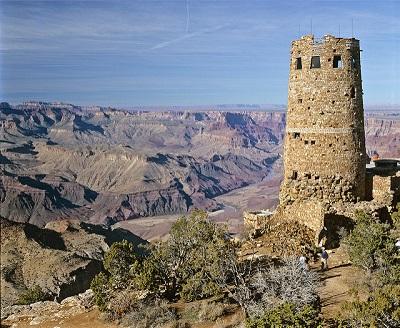
Grand Canyon National Park/NPS.
A Finding of No Significant Impact was signed by Kate Hammond, acting Regional Director for the Intermountain Region of the National Park Service, for a site plan to both transform Desert View in Grand Canyon National Park into an Inter-tribal Cultural Heritage Site and share a unifying message from the park's traditionally associated tribes: "we are still here."
The National Park Service is committed to honoring the cultural, historic, and spiritual connections that each tribe holds to the Grand Canyon. The effort would provide Grand Canyon National Park visitors with greater understanding of Native American use and cultural views of the canyon via an Inter-tribal Cultural Heritage Site at Desert View.
Located at the southeast edge of Grand Canyon National Park, Desert View is near the east entrance, and provides many visitors with their first introduction and orientation to some of the park's most significant resources, including the Desert View Watchtower, a national historic landmark, and its surrounding historic district. The area also offers spectacular views of the Painted Desert and the Little Colorado River Gorge.
Over the last five years, the National Park Service has worked collaboratively with representatives from the Kaibab Band of Paiute Indians (representing five bands of Southern Paiute Indians), Havasupai, Hopi, Hualapai, Navajo, Zuni, and Yavapai-Apache tribes; the Grand Canyon Conservancy; the American Indian Alaska Native Tourism Association; the Bureau of Indian Affairs; and park concessioners to increase cultural demonstrations at Desert View and identify the necessary infrastructure needed to transform the area into an Inter-tribal Cultural Heritage Site.
In 2018, the National Park Service prepared an Environmental Assessment for the Desert View Inter-tribal Cultural Heritage Site Plan. In accordance with the National Environmental Policy Act, the assessment evaluated a no action alternative and one action alternative. Public comments received during a 30-day public comment period, that ended November 24, 2018, were used in preparation of the FONSI.
Under the park's selected action, the National Park Service will continue to partner with associated tribes and park partners to create authentic, first-voice tribal interpretation and expand opportunities for cultural and educational programs including demonstrations, exhibits, and personal interactions with tribal representatives and artisans. In support of these expanded programs, the National Park Service will modify existing infrastructure, rehabilitate and reuse historic buildings, and complete some new construction within the existing developed footprint at Desert View.



Comments
No such thing under our United States Constitution as a 'Bureau of Indian Affairs!'
Nor was there an internet, Paul.
[edited because using the wrong 'there/their/they're' deflates your own sails.]
Paul, there wasn't a BIA under our Constitution because we hadnt yet displaced hundreds of Indian nations across the country. We had only started.